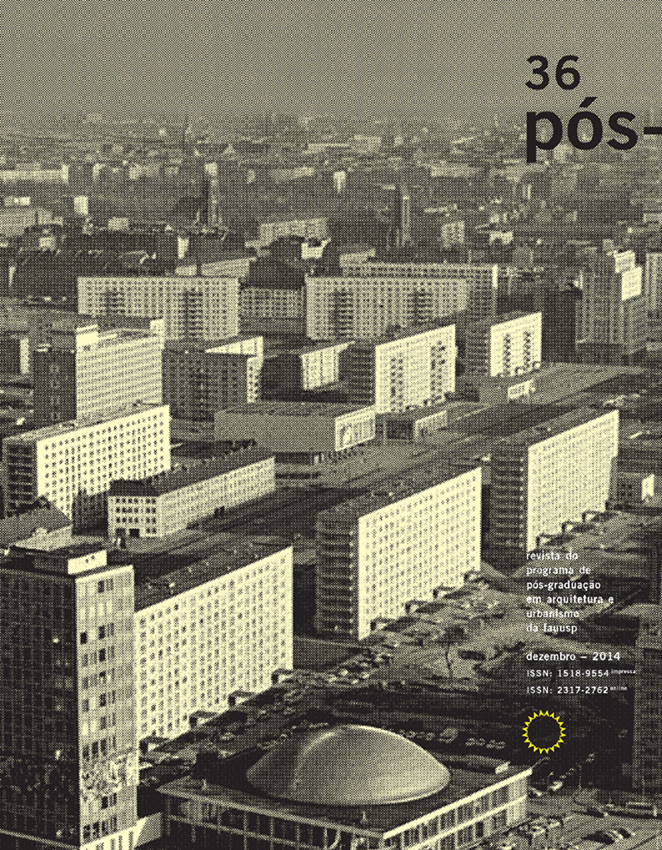Habitação de iniciativa pública em Luanda e Maputo: modelos de intervenção e impactos socioterritoriais no novo milénio
DOI:
https://doi.org/10.11606/issn.2317-2762.v21i36p124-140Palavras-chave:
Habitação. Políticas públicas. “Direito à cidade”. Condomínio em altura. Luanda. Maputo.Resumo
No início do novo milénio, em pleno contexto global neoliberal, Luanda e Maputo assistem à consolidação de diferentes paradigmas de intervenção urbana, associados a determinados modelos habitacionais de iniciativa pública, evidenciando-se os condomínios em altura e a habitação de piso único de crescimento extensivo. Atendendo às especificidades contextuais dessas duas capitais lusófonas e a suas grandes desigualdades socioterritoriais, recorremos ao conceito de «direito à cidade» para, por meio da análise de quatro casos de estudo, refletir sobre a adequação das soluções adotadas no âmbito desses dois modelos habitacionais, para a redução dessas desigualdades, no que se refere: às condições de habitabilidade, ao acesso aos benefícios da urbanização e à participação e apropriação de uma vida urbana transformada. Nesse contexto, onclui-se que existe um desequilíbrio entre o investimento estatal e as reais necessidades da maioria da população, tendencialmente de baixos recursos, que limita o «direito à cidade», no que se refere ao acesso às condições de habitabilidade e aos benefícios da urbanização. Esta limitação verifica-se quer nos condomínios em altura, direcionados para uma população de média e alta renda, quer na habitação de piso único de crescimento extensivo, mais adaptada à classe de menores recursos e onde a apropriação é possibilitada em ambos os contextos. Nenhum dos casos engloba todos os direitos contemplados pelo «direito à cidade», mas Maputo apresenta um panorama mais favorável, em parte devido a uma maior abertura à descentralização e participação popular na tomada de decisões e partilha de responsabilidades.
Downloads
Referências
ANGOLA. Alteração da Divisão Político-Administrativa das Províncias de Luanda e Bengo (2011). Lei n. 29/11 (2011). Diário da República, Luanda, 2011.
ANGOLA. Lei de Bases do Fomento Habitacional (2007). Lei n. 03/2007. Diário da República, Luanda, 2007.
ANGOLA. Lei de Terras (2004). Lei n. 9/2004. Diário da República, Luanda, 2004.
ANGOLA. Lei do Ordenamento do Território e do Urbanismo (2004). Lei n. 3/2004. Diário da República, Luanda, 2004.
ANGOLA. Planos Integrados de Expansão Urbana e Infra-Estruturas de Luanda e Bengo (2011). Decreto Presidencial n. 59/11. Diário da República, Luanda, 2011.
ANGOLA. Regulamento Financeiro Funcional e Organizacional do Fundo de Fomento Habitacional (FFH) (2009). Decreto-Lei n. 54/09. Diário da República, Luanda, 2009.
CONSELHO MUNICIPAL DE MAPUTO. Plano de Estrutura Urbana do Município de Maputo (PEUMM). Maputo: Conselho Municipal de Maputo, 2008.þ
FAURÉ, Yves. Angola e Moçambique: de uma descentralização prometida a uma descentralização tímida. In: FAURÉ, Yves, RODRIGUES, Cristina (org.). Descentralização e desenvolvimento local em Angola e Moçambique: processos, terrenos e atores. Coimbra: Almedina, 2011. 358 p.
GAMEIRO, António. O actual desenvolvimento urbano e habitacional em Angola. In: CONGRESSO INTERNACIONAL (DA) HABITAÇÃO NO ESPAÇO LUSÓFONO, 1, 2010, Lisboa. Proceedings… Lisboa: ISCTE-IUL / CIAAM / FAUTL/ CIAUD, 2010.
HARVEY, David. The right to the city. New Left Review. London, n. 53, p. 23-40, Sept/Oct 2008. Disponível em: http://www.newleftreview.org/?view=2740. Acesso em: 20 out. 2011.
JENKINS, Paul. National and international shelter policy initiatives in Mozambique: housing the urban poor at the periphery. 1998. [385] f. (Doutorado em Urbanismo) - Centre for Environment & Human Settlements School of Planning & Housing Edingurgh College of Art Heriot-Watt University Edinburgh, Edimburgo. 1998.
JENKINS, Paul; WILKINSON, Peter. Assessing the growing impact of the global economy on urban development in southern African cities - Case studies in Maputo and Cape Town. Cities, v. 19, n. 1, p. 33-47, 2002.
LEFEBVRE, Henri. Le droit à la ville. 3ª ed. Paris: Económica e Anthropos, 2009. 135 p.
LOPES, Carlos; OPPENHEIMER, Jochen; PROENÇA, Carlos Sangreman;
RIBEIRO, Mário; CUNHA, Nuno; FERREIRA, Marco. Economia de Luanda e Maputo: olhares cruzados. In: OPPENHEIMER, Jochen; RAPOSO, Isabel (Coords.). Subúrbios de Luanda e Maputo. Lisboa: Edições Colibri, 2007. 330 p.
MELO, Vanessa. Urbanization processes in the expansion areas of Luanda, Maputo and Johannesburg: urban planning and everyday practices. In: INTERNATIONAL PLANNING HISTORY
SOCIETY CONFERENCE, 15, 2012, São Paulo. Proceedings… São Paulo: Universidade de São Paulo/ IPHS, 2012. Disponível em: http://www.fau.usp.br/15-iphs-conference-sao-paulo-2012/abstractsAndPapersFiles/Sessions/36/MELO.pdf. Acesso em: 10 out. 2012.
MOÇAMBIQUE. Lei de Terras (1997). Decreto-lei n. 19/1997. Boletim da República. Maputo, 1997.
MOÇAMBIQUE. Lei do Ordenamento do Território (2007). Lei n. 19/2007. Boletim da República. Maputo, 2007.
MOÇAMBIQUE. Política e Estratégia de Habitação (2011). Resolução n. 19/2011. Boletim da República. Maputo, 2011.
MOÇAMBIQUE. Programa Quinquenal do Governo 2010-2014 (PQG 2010/14). Maputo: [s.ed.], 2010.þ
NIELSEN, Morten. Inverse governmentality: The paradoxical production of peri-urban planning in
Maputo, Mozambique. Critique of Anthropology, v. 31, n. 4, p. 329-358, 2011. DOI: https://doi.org/10.1177/0308275X11420118
RAPOSO, Isabel. Instrumentos e práticas de planeamento e gestão dos bairros periurbanos de Luanda e Maputo. In: OPPENHEIMER, Jochen; RAPOSO, Isabel (Coords.). Subúrbios de Luanda e Maputo. Lisboa: Edições Colibri, 2007. 330 p.
RAPOSO, Isabel; JORGE, Sílvia; MELO, Vanessa; VIEGAS, Sílvia. Luanda e Maputo: Inflexões suburbanísticas da cidade socialista à cidade-metrópole neoliberal. URBE, Curitiba, v. 4, n. 2, Jul/Dez.2012. Disponível em: http://www2.pucpr.br/reol/index.php/URBE?dd1=7395&dd99=view. Acesso em: 20 jan. 2011. DOI: http://dx.doi.org/10.7213/urbe.7395
VIEGAS, Sílvia. Urbanization in Luanda: geopolitical framework. A socio-territorial analysis. In: INTERNATIONAL PLANNING HISTORY SOCIETY CONFERENCE, 15, 2012, São Paulo. Proceedings… São Paulo: Universidade de São Paulo / IPHS, 2012. Disponível em: http://www.fau.usp.br/15-iphsconference-sao-paulo-2012/abstractsAndPapersFiles/Sessions/29/VIEGAS.pdf. Acesso em: 10 out. 2012.
UN-HABITAT. Mozambique Urban Sector Profile. Maputo, Nacala and Manica. 2010a. Disponível em: http://www.unhabitat.org/pmss/getElectronicVersion.asp?nr=2448&alt=1. Acesso em: 13 jan. 2011.
UN-HABITAT. The State of African Cities 2010: Governance, inequality and urban land markets. 2010b. Disponível em: http://www.unhabitat.org/documents/SACR-ALL-10-FINAL.pdf. Acesso em: 13 jan. 2011.
Downloads
Publicado
Edição
Seção
Licença
O detentor dos direitos autorais é o autor do artigo. A revista exige apenas o ineditismo na publicação do artigo. O autor tem do direito de divulgar seu artigo conforme sua conveniência devendo citar a revista.
DIADORIM - Diretório de Políticas Editoriais












